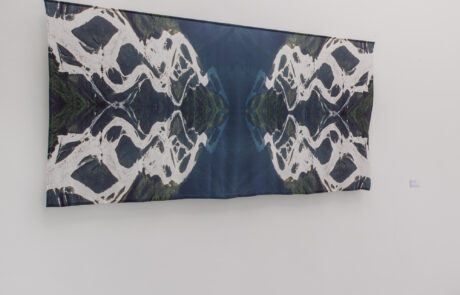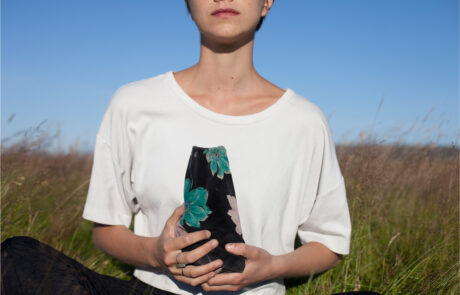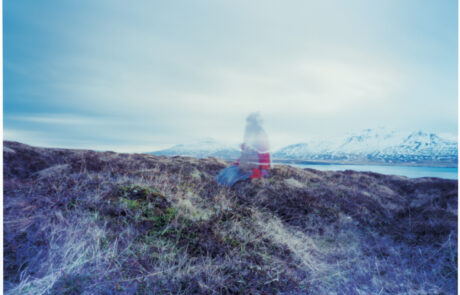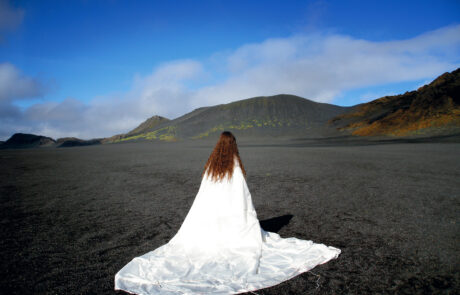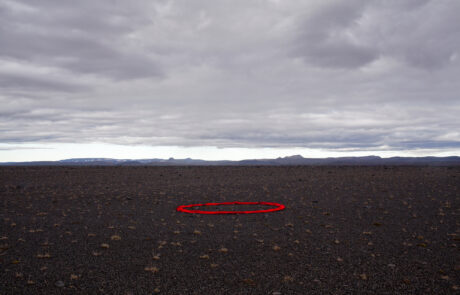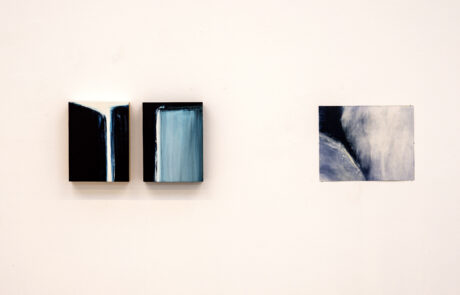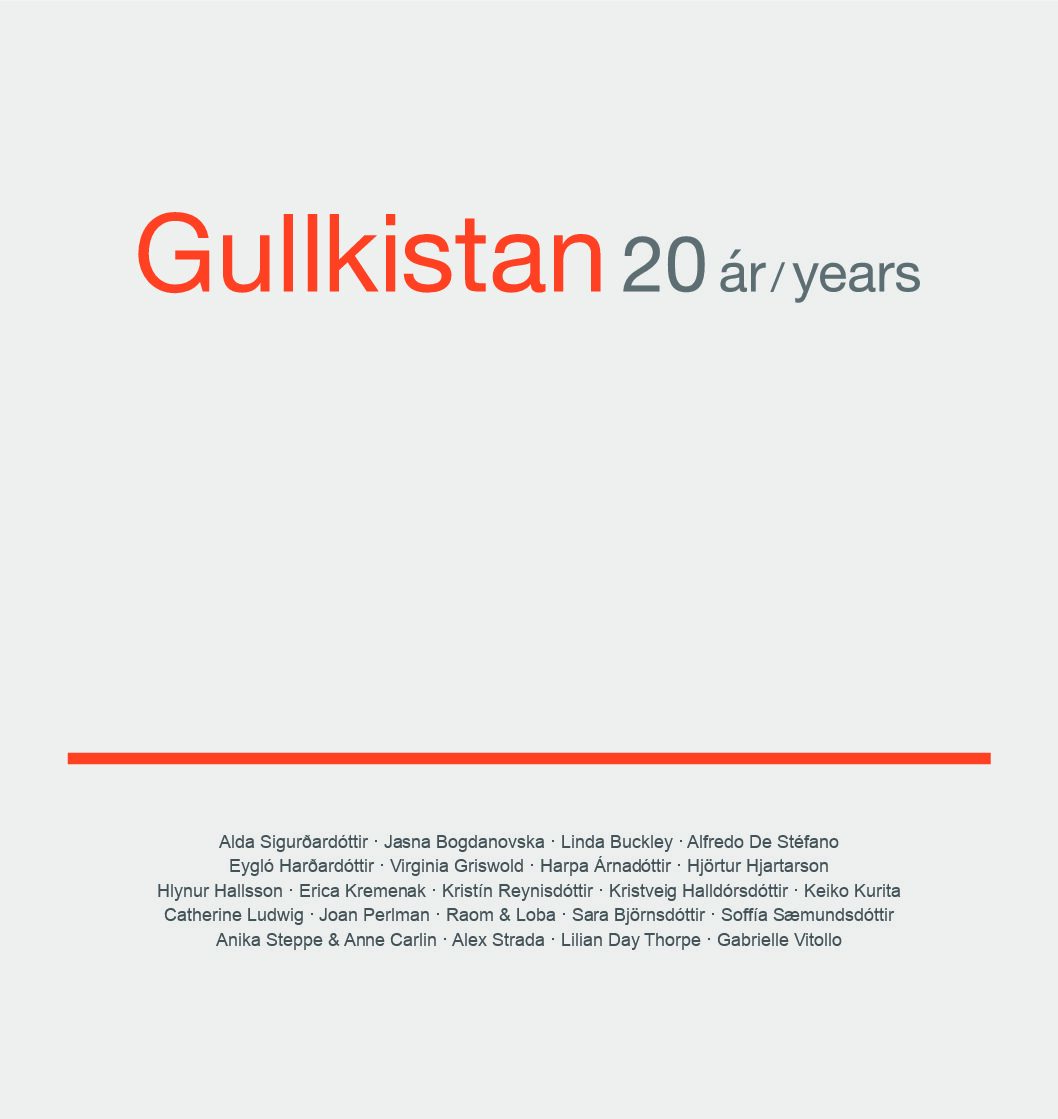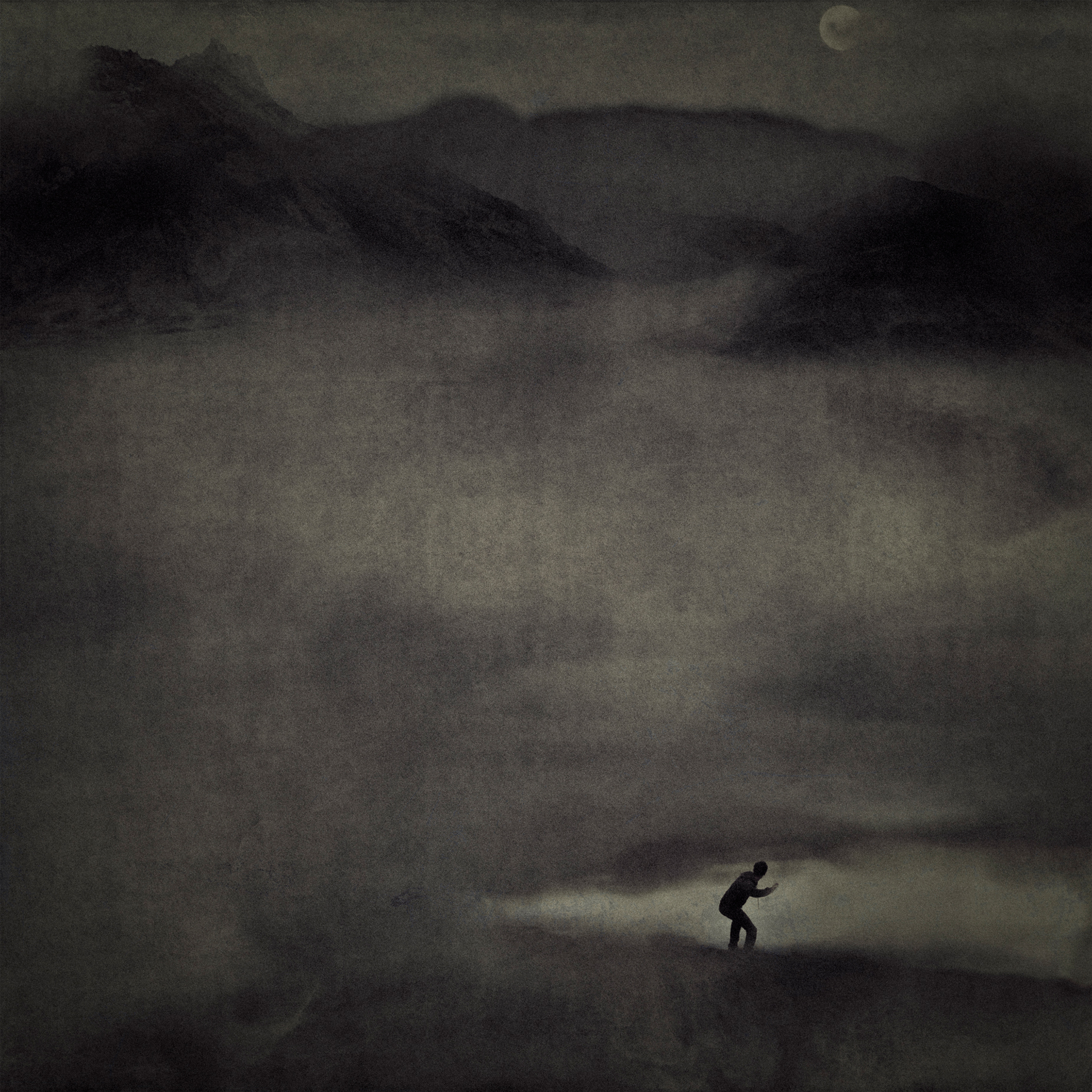
Gullkistan: 20 years
July 19 – September 20, 2015
Ben Valentine
For twenty years Gullkistan has served as inspiration and community for hundreds of artists worldwide. This exhibition celebrates the anniversary by featuring recent work by some of the creative, diverse, and exceptional artists nurtured by Gullkistan’s vision and support of the founders, artists Alda Sigurðardóttir and Kristveig Halldórsdóttir.
Laugarvatn’s isolation in Southern Iceland has fostered a rich artistic lineage that predates the center. Þórarinn B. Þorláksson, a renowned Icelandic artist, spent much of his later life in Laugarvatn. Halldór Kiljan Laxness, winner of the 1955 Nobel Prize in Literature frequented Laugarvatn. Continuing this tradition, Gullkistan held its first art festival in 1995, when more than 130 artists and creatives flocked there to make and share their work. In 2005, on the tenth anniversary of that inaugural festival, Gullkistan reconvened, and over 140 creatives once again stormed Laugarvatn, taking over schools, restaurants, gyms, pools, and the surroundings. The center of the festivals was Héraðsskólinn, the famous building designed by Guðjón Samúelsson. Together, they came to celebrate all forms of creativity – a vibrant and sophisticated artistic, musical, and literary culture both Icelandic and international in scope and vision. Out of these two spectacular festivals, Gullkistan’s residency program was born. Housing over 200 residents in the last 6 years, Gullkistan has served as a meeting ground for a wide range of creative expression and community.
Gullkistan: 20 Years features 24 artists from 8 countries representing the diversity and quality of recent work of participants throughout the 20 years. How Gullkistan touched and inspired each and every one of these artists, and the indelible mark they left behind.
I first came to Gullkistan as a resident in 2012. I had just spent two years working in the arts while living in Brooklyn, NY, and I was eager for a quiet place to clear my head in a beautiful landscape. The sublime nature of Iceland and the quiet retreat did not disappoint. I came back as an intern in 2014, and afterwards I was asked to curate this exhibition.
Usually, what I love about curating shows is first finding a cohesive and intellectually stimulating concept, and then scouting for the artists that best fit. Gullkistan: 20 Years, did not allow for that at all. With over 300 artists involved over the years, I had to look through them all to find the themes that emerged. Going through the list of artists, I kept asking, how do I honestly represent an institution with such a rich history of so many artists and activities? What themes of concept and material should I choose that can represent the diversity and creativity of Gullkistan? Gullkistan sits at a unique intersection of Laugarvatn’s history, landscape, and the many creatives who have passed through; this exhibition needed to capture that.
Gullkistan: 20 Years features 22 artists from 7 countries, with videos, paintings, photographs, sculpture, installation, music, and textile on display. While the inspiration and execution varies, the glue that brings them all together is Gullkistan.
The more I thought about what an exhibition about Gullkistan meant, the more I wanted Alda and Kristveig’s work to be featured in the show. At first, they were opposed to the idea; they wanted to celebrate the artists involved in their festivals and residency, not themselves. But despite their initial hesitation, they eventually agreed, and their works are the first you see. Alda’s site-specific installation, Laugarvatn in front of the museum suggests her now absent body in relation to the museum, with her feet pointing towards Laugarvatn. This is a conceptual and physical gesture marking the presence of her body as well as Laugarvatn’s influence on the artists throughout the exhibition. Kristveig’s piece, Sensitive landscape, is a tantalizing large silk print of an Icelandic valley and river. With a few simple edits, the photograph was mirrored, transforming it nearly to the point of an abstract painting. Snow, water, rock, and moss become colors Kristveig uses like paint for the stunning tapestry. The result of this process invites closer inspection from the viewer to try and ascertain the photograph’s location.
Alda and Kristveig have created a nurturing and creative space where all are welcome. Gullkistan is committed to inclusivity for creative and free expression, and that’s why it’s been so successful. Indeed, to wrap all of this into a simple theme would belittle the vibrancy of the program, and miss the point of Gullkistan. But I’m not one for cluttered, anything-goes exhibitions. I wanted a way to fairly but beautifully represent Gullkistan while inside the museum. I wanted to capture that raw energy and diversity as best as I could in a visually exciting and appealing manner. So I changed course, and sought to find great work from a diverse range of Gullkistan’s many talented artists. Gullkistan: 20 Years, is not a retrospective, this is a snapshot of artists who have been involved with Gullkistan and are still actively producing work today. One could search for a coherent theme in Gullkistan: 20 Years, but you’d be disappointed.
Tourists eagerly talk about the sublime beauty of the Icelandic landscape, and it is definitely a draw for many international artists coming to Gullkistan. You can see an undeniable influence of Iceland’s nature in Gullkistan: 20 Years, but this exhibition does not continue that stereotype. Hekla, the powerful volcano that looms over Laugarvatn is just as central to Gullkistan as the village. Laugarvatn is a destination with a complex list of inspiration and influences, nature being but one of them. Still, we find the colors that are so representative of Iceland’s environment. There are the beautiful ice-blues that you see in Joan Pearlman, Erica Kremenak, and Gabrielle Vitollo’s powerful semi- abstract paintings. By emphasizing color and abstracting form to a nearly unidentifiably degree, these artists capture the raw energy that the landscape possesses here. The endless variety of moss green is present in Hjörtur Hjartarson’s two large abstract paintings.
Iceland’s notoriously moody and mysterious atmospheric sensibility can be found in many of the works. Linda Buckley’s Hekla series were written while looking out on the volcano, but also inspired by old Gaelic poetry of love and loss. Keiko Kurita and Lilian Day Thorpe’s photographs and Soffía Sæmundsdóttir’s paintings too have a mysterious sensibility about them. Yet these photographs and paintings use the lighting as a setting for the story, not the subject. All of these and more are inspired by the Icelandic landscape. But this is not a show about nature. We find Alexandra Strada’s candid and at times hilarious photographs of contemporary Icelanders. Anika Steppe and Anne Carlin document a traditional Icelandic baking process. Using video art to weave between scenes of nature, the traditional baking process, and contemporary life, Steppe and Carlin portray contemporary Iceland as comfortably in between both nature and society. Strada shows us an honest portrayal of daily Iceland that is not romanticized as a wilderness, but far from it.
Eygló Harðardóttir’s sculptures, Paintings, also invite a distinctive way of considering and interacting with our surroundings, not only the Icelandic landscape. Using colored plastics and bright paints for her sculptures, Eygló asks us to use her work as an unexpected lens for gazing at the world. They invite play and exploration without a fetishizing ideal of nature. Harpa Árnadóttir’s large painting, Surface of Memory, is simply cracked white paint. This process painting is a classic Modernist work about the materiality of paint. Conversely, the work also suggests ice, snow, and tundra in mesmerizing detail. These are exactly the conflicts and juxtapositions of Gullkistan: 20 Years. Catherine Ludwig’s fun sketches capture a rock mid-fall. Was it thrown from a volcano or a child’s hand? Where will it land? These simple drawings are a pleasure for imagining the story behind them and examining their meticulous lines. Ironically, shortly after realizing she was not the type of person for delicate and attention-demanding crafts like Origami, Sara Björnsdóttir was given a book on Origami as a present. Instead of making any of the meticulous creations inside, she decided to make her own, “Origami Snowballs.” Both artists’ use of very simple and playful gestures has more to do with how our minds perceive the work than the forms shown.
Alfredo De Stéfano and Jasna Bogdanovska’s photographs as well as Virginia Griswold’s video all feature a contemporary subject while the Icelandic landscape falls into the background. De Stéfano and Griswold’s works are very much in the lineage of Land Art, capturing the artist’s engagement with the environment. They both highlight a simple gesture that draws attention to the setting’s light and color while Bogdanovska’s work is more complex and narrative in scope. As a meeting ground of two tectonic plates, Bogdanovska uses Iceland’s geographic uniqueness as a conceptual locale to explore ideas of foreignness and immigration. Having lived half of her life in the US and the other raised in the Republic of Macedonia, Bogdanovska’s metaphor is powerful. Iceland has a rich narrative tradition, and Southern Iceland has been a part of many a saga and myth. Artist duo Raom and Loba as well as Soffía are weaving contemporary stories, yet are undoubtedly influenced by this Icelandic tradition. Raom and Loba’s images taken in Iceland speak of foreigners exploring a completely alien landscape. Seemingly every article about Iceland in the US mentions elves, and they are here too. Hlynur Hallsson’s images act as a diary of his travels, but are far from epic or mythical in nature. Spanning five years and constant travel, Hlynur captures everyday moments and subtitles them for us in Icelandic, German, and English. The micro-stories resist any grand narrative, opting instead for intimate and simple reflections on his daily life, a life on the go and often spanning multiple countries.
Kristín Reynisdóttir’s installation represents the sacred geometry of the “flower of life,” found in many religions throughout the world. The piece is a continuation of her work at the 1995 festival, and is in that way indicative of the creativity and passion that has spiraled out from Gullkistan over the years.
In a separate room there are images documenting the first two festivals and other activities important to Gullkistan’s history and mission. There are an overwhelming number of locations and works that comprised the two festivals that later became the foundation from which the residency program formed. These images and documents capture the wonderful chaos of the festivals. Furthermore, Gullkistan’s history includes numerous events, which is also documented. Like the exhibition, these images and texts only scratch the surface of all of the art and talent that has come through Gullkistan. Displaying everything that Gullkistan has been a part of throughout the twenty years is impossible.
Gullkistan: 20 Years shows us that Gullkistan is active in today’s world and inspired by a plethora of subjects and stories. Gullkistan’s history is one that echoes outwards; with hundreds of artists from all over the world inspired by their time at Laugarvatn. I invite you to bring your own creativity and imagination when viewing this exhibition, and I hope you enjoy the show.
Curator:
Ben Valentine BNA / USA
Valentine (1989) is an independent writer and curator exploring how technology, art, and politics intersect around the world. He has written and spoken for SXSW, Salon, SFAQ, Hyperallergic, VICE, and The New Inquiry to name a few. Valentine has curated several exhibitions, including the World’s First Tumblr Art Symposium, in NYC; Global Space, for the Indianapolis Museum of Contemporary Art; and Unmasking the Network for A Simple Collective in San Francisco. Valentine currently lives in Cambodia.
Artists:
Alda Sigurðardóttir / Iceland
Sigurðardóttir (1960) studied fashion design in Paris (1985) and then graduated from the Icelandic college of Arts and Crafts in 1993, multimedia department. Alda has done various jobs: within theatre, as a designer, managed various events and runs her own business. She has participated in numerous group exhibitions and held several solo exhibitions at home and abroad. Alda ran the international exhibition space GUK with two other artists (1999-2006), created the outdoor exhibition Ferryplace (2009) and is co-founder and director of Gullkistan. Alda has also participated in various social activities, among others being a board member of the Living Art Museum and the Association of Visual Artists.
Jasna Bogdanovska / USA
Bogdanovska (1978) is a photographer, educator, avid traveler and explorer of different cultures. She explores issues of femininity, culture, religion, nostalgia and belong- ing using various mediums such as photography, installation and video. She exhibits her work internationally in solo as well as group exhibitions. She is a tenured Assistant Profes- sor of photography at Monroe Community College and is the EYP President at the International Museum of Photo- graphy and Film at the George Eastman House in Rochester, NY. Bogdanovska is from Macedonia and grew up there.
Linda Buckley / Ireland
Linda Buckley, (1979) is a composer based in Dublin. Her music has been described as “exquisite” (Gramophone) „strange and beautiful“ (Boston Globe), “glacially majestic” (RTÉ Ten) with “an exciting body of work that marks her out as a leading figure in the younger generation of Irish composers working in the medium” (Journal of Music). Her work has been performed by the BBC Symphony Orchestra, Dresden Sinfoniker Orchestra, Crash Ensemble, Fidelio Trio and at international festivals. Linda was RTÉ lyric fm Composer in Residence from 2011/13 and after music studies at UCC and Trinity College, now lectures at Trinity College Dublin.
Alfredo De Stéfano / Mexico
De Stéfano (1961) was born in Mexico in the middle of the desert. He is passionate about the landscape, and specifical- ly the desert, a panorama that he has traveled through innu- merable times. He has had many solo and group exhibitions, and his work has been shown on five continents including Paris, Sao Paulo, New York, Washington, Madrid, Bogota and Buenos Aires, among others. He has been a member of the National System of Creators since 2008.
Eygló Harðardóttir / Ísland
Harðardóttir (1964) graduated from the Icelandic college of Arts and Crafts and AKI – Akademie voor Beeldende Kunst in Enschede in the Netherlands. In 2014 she completed an MA degree in art education from Iceland Academy of Art with the research thesis “Art gives an indication of three- dimensional approach to color studies”. Recently Eygló has been working with composite paintings that are often abstract sculptures, site-specific works and videos. In her work she explores limits of painting within the interplay of space and audience. Eygló has worked and exhibited in Iceland and abroad and her works are in several museums’ collections.
Virginia Griswold / USA
Griswold (1981) received an MFA in Sculpture/Glass from Alfred University, NY, USA in 2011 and a BFA in Glass/ Mate- rial Studies from Virginia Commonwealth University in 2004. In 2009, she received a Brooklyn Arts Council Re-Grant and in 2011 she was awarded a residency fellowship from Alfred University to study at the Cité Internationale des Arts in Paris. She is currently an Assistant Professor of Sculpture and 3D Foundations at Austin Peay State University, Tennessee.
Harpa Árnadóttir / Iceland
Árnadóttir (1965) is known for her paintings, both those she calls “crack paintings” and those rendered in watercolour. She studied art at the Icelandic College of Art and Crafts and then moved to Sweden to study at Konsthogskolan Valand in Gothenburg. Árnadóttir’s works have been acquired and exhibited by museums throughout Europe and have been featured at the first Gothenburg Biennial and Momentum, the 6th Nordic Biennial of Contemporary Art.
Hjörtur Hjartarson / Iceland
Hjartarson (1961) graduated from the Icelandic college of Arts and Crafts in 1996, multimedia department and studied drawing at the University of Granada in Spain 1996 -1997. He tackles nature ́s colors and forms that he usually seeks in a small valley that he has known since childhood, near Reykjavík. The valley is rich in colours due to the variety of plant life and ecology. A river flows through and lakes and ponds are there too. On calm days the water reflects the environment and the river ́s bottom growth glistens. Hjartarson ́s works are regularly exhibited both in Iceland and abroad.
Hlynur Hallsson / Iceland
Hallsson, (1968) lives and works in Hanover and Akureyri. He studied at the Akureyri School of Visual Arts, the Icelandic College of Art and Crafts, and at FH Hannover, HfbK Hamburg, Kunstakademie Düsseldorf. Since 1999 he has held lectureships at the Akureyri School of Visual Arts and the Iceland Academy of the Arts. Through photography, text, installation, and performance, Hlynur explores concepts such as political imperialism, national and cultural borders in a globalizing world, and communication across lines of difference.
Erica Kremenak / USA
Kremenak (1956) received a Bachelors Degree in Fine Art from the University of Iowa in 1979, and studied sculpture and painting at San Francisco State University and the San Francisco Art Institute. Currently, she lives and works as a painter, photographer and designer in Oakland, California.
Kristin Reynisdóttir / Iceland
Kristin Reynisdóttir (1961) studied art at Akademie der Bildenden Kunste in Düsseldorf, Germany, the Icelandic School of Art and Craft, and Pilchuck Glass School in the US. Kristin has had solo exhibitions in Iceland, Germany, Norway and Finland. Kristin is a member of the Reykjavik Association for Sculpture, the Association of Icelandic Visual Artists and the Living Art Museum. She has received several grants for her work, including from the Icelandic Ministry of Culture, the State Fund for Icelandic Artists, and the Scandinavian Artists grant.
Kristveig Halldórsdóttir / Iceland
Halldórsdóttir, (1964) is the co-founder and director of Gullkistan as well as an artist and teacher in Reykjavík. She got her master’s degree from the Oslo National Academy of Art (SHKS) in 1998, where she specialized in textile art using handmade paper and various plant fibers, which she continued to use after returning to Iceland. Her art has since then gradually evolved into using other media and techniques, especially photography and computer graphics, usually connecting the mediums with textile.
Keiko Kurita / Japan
Kurita, (1975) is a Japanese photographer with a Masters in Image and Communication from Goldsmiths, University of London. Through digital and traditional photography, her works involve a realization of the notion that fantasy is present in truth by believing. She has exhibited this series in solo-exhibitions in Tokyo, Reykjavik and London.
Catherine Ludwig / Austria
Ludwig (1976) works and lives in Vienna and is a transmedia artist, transcending traditional barriers between individual media during the process as well as on the result. Ludwig studied graphic design in Nürnberg (Germany) and transmedia art in Vienna (Austria) at the University of Applied Arts. She has had numerous artist residencies and exhibitions in Taiwan, Germany, Austria, Italy, USA and Iceland. Catherine Ludwig is represented by Galerie Reinthaler in Vienna.
Joan Perlman / USA
Perlman is a Los Angeles-based visual artist. Her paintings and video work have been featured in many solo and group exhibitions at venues in the US and abroad, including Fringe Exhibitions, Los Angeles; Wave Hill, New York; Tufts University Art Museum, Boston; Long Beach Museum of Art, CA; and Hafnarborg, Iceland. In 2014 she received The American-Scandinavian Foundation Grant for the Creative Arts, and a Puffin Foundation Grant in Photography.
Raom & Loba / France
Raom (1962) studied illustration at Escuela de Bellas Artes, Buenos Aires. Loba (1972) is a graphic designer, and studied at Paris VIII University. They have worked on photographic series as a duo since 1998, but also on drawings, etching, sculptures and video works. Their work has been shown in numerous exhibitions internationally. Each photograph is a fragment of a vast story and brings to light some aspects of human nature by making them symbolically visible.
Sara Björnsdóttir / Iceland
Björnsdóttir (1962) studied at the Icelandic College of Art and Crafts and at the Chelsea College of Art and Design in London and currently lives and works in Reykjavík. In her multifaceted work, Sara mirrors our experiences of daily life by means of her self-exposing performances, photographs and videos, but she is also an attentive observer of our external environments. As she incessantly reveals herself through her art, she gives us the tacit approval to confess to ourselves our beauty as well as our failures.
Soffía Sæmundsdóttir / Iceland
Sæmundsdóttir (1965) graduated from the Icelandic College of Art and Crafts, graphic department in 1991, got her MA degree in painting from Mills College, California in 2003 and her MA degree in art education from Iceland Academy of Art in 2010. For years she has organized numerous exhibitions, participated in group exhibitions, teaches art and runs a studio. She has also participated in extracurricular artists including the chairman and the exhibition company Icelandic graphics. Her works are included in private and official collections. She has received international and domestic awards and has been selected to participate in exhibitions on behalf of Iceland.
Anika Steppe and Anne Carlin / USA
Steppe, (1991) and Anne Carlin, (1990) traveled to Iceland for the winter of 2014 where they were part of two artist residencies. During this time they collaborated on the short film titled “Total Time:” which they produced during their stay at Gullkistan. Anika primarily works with still photography while Anne works in the documentary filmmaking realm. They are both based in Brooklyn, NY.
Alex Strada / USA
Strada (1988) is a photographer based in New York City. Her work has been exhibited throughout the US, in Germany, Belgium, Mexico and Iceland where she also participated in a Mary Ellen Mark workshop. For Strada photography is “such an important tool for slowing down and looking around, and thinking about our existence.” She is currently pursuing an MFA at Columbia University.
Lilian Day Thorpe / USA
Day Thorpe, (1991) received her BFA from Pratt Institute in NYC in 2014, graduating with highest honors. Thorpe’s photographs are digital montages that she constructs in Photoshop using her own original photographs. The results are fictional landscapes that appear more painterly than photographic. She strives to portray a similar “hand-paint- ed” quality in her photographs, just as the Pictorialists did. In the fall, Thorpe will return to Pratt to earn a MA in art history.
Gabrielle Vitollo / USA
Vitollo, (1989) received a BFA from the Maryland Institute College of Art in 2012, and has participated in numerous art residencies, including La Macina di San Cresci, Greve, Italy (2013) and ARNA, Avian Kingdom, Sweden (2012). She is a two-time recipient of the Elizabeth Greenshields Foundation grant (2001 and 2013). Solo exhibitions include “Recent Work: Gabrielle Vitollo,” at Well Point, Philadelphia, PA (2013); “States of Being,” MICA Gateway Gallery, Baltimore, MD (2011); and “Visceramacchina,” MADWAL Gallery, New York, NY (2014). She will begin her MFA at New York University Steinhardt in the fall of 2015.
Here you can download the catalogue in Pdf. format.


